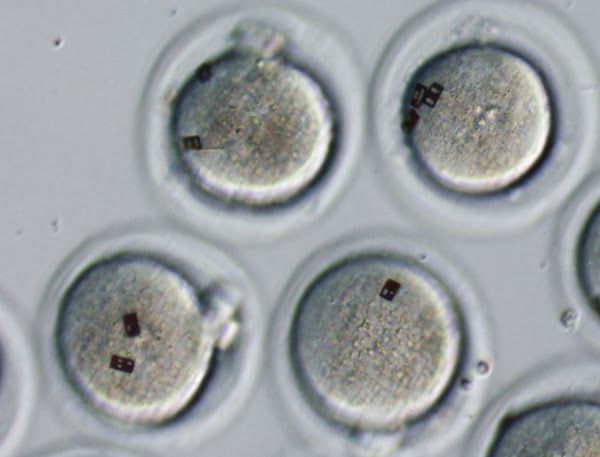
(Image from New Scientist)
I have never worked in manufacturing but I can imagine inventory and quality control are important parts of the process. Keeping track of inventory and making sure the right parts get to where they are needed would be a priority. The barcode has surely revolutionized the manufacturing industry.
The barcode is certainly finding a home in the human manufacturing plant, also known as the IVF clinic. Scientists from Barcelona have announced in the journal, Human Reproduction, that they now can place a barcode tag directly on an embryo to make sure you end up with the right kid. Because mix-ups do happen. The abstract reads:
STUDY QUESTION Is the attachment of biofunctionalized polysilicon barcodes to the outer surface of the zona pellucida an effective approach for the direct tagging and identification of human oocytes and embryos during assisted reproduction technologies (ARTs)?
SUMMARY ANSWER The direct tagging system based on lectin-biofunctionalized polysilicon barcodes of micrometric dimensions is simple, safe and highly efficient, allowing the identification of human oocytes and embryos during the various procedures typically conducted during an assisted reproduction cycle.
WHAT IS KNOWN ALREADY Measures to prevent mismatching errors (mix-ups) of the reproductive samples are currently in place in fertility clinics, but none of them are totally effective and several mix-up cases have been reported worldwide. Using a mouse model, our group has previously developed an effective direct embryo tagging system which does not interfere with the in vitro and in vivo development of the tagged embryos. This system has now been tested in human oocytes and embryos…
WIDER IMPLICATIONS OF THE FINDINGS The direct embryo tagging system developed here provides fertility clinics with a novel tool to reduce the risk of mix-ups in human ARTs. The system can also be useful in research studies that require the individual identification of oocytes or embryos and their individual tracking.
Barcodes, freezers, mix-ups. Inventory control. Is this really the best way to start one’s life?
Where else does a parent have to physically barcode a child to make sure they don’t accidentally get misplaced somewhere? (I am not talking bracelets here; I am talking barcoding their bodies.)
You can’t tell me that IVF doesn’t take human procreation and turn it into human manufacturing.
Hat Tip: BioEdge
Rebecca Taylor blogs at Mary Meets Dolly

Leave a Reply